Personalizing the online shopping experience in 2025
Written by
Editorial TeamPublished on
See how well-known brands are personalizing their online shopping experience in 2025.

In 2025, the world’s most forward-thinking companies – like Mastercard, Shopify, Channable, Worldpay, Stripe, Salesforce, Nosto, Adyen, and Algolia – are changing what people expect from e-commerce.
They’re using AI and live data to make every click checkout feel like it was built just for you.
How is it done and how can you take advantage of these innovations?
Let’s find out together.
Table of contents:
Personalized recommendations
#Case 1 Shopping Muse by Mastercard
#Case 2 Shopify’s unified customer profiles in action
Dynamic pricing & payment personalization
#Case 3 Channable’s AI-powered repricing for marketplaces
#Case 4 How Worldpay powers profit optimization
Custom customer journeys
#Case 5 Stripe’s API-led customization
#Case 6 SalesForce’s Agentforce AI Orchestration Engine
#Case 7 Nosto’s AI onsite behavior tracking
Customer success & Support personalization
#Case 8 Adyen’s platform
#Case 9 Algolia’s advanced personalization
Over to you
Personalized recommendations
Numbers that speak:
- 81% of people lean toward brands that shape their experience around them.
- AI-powered recommendations lift sales by 25% and can grow average spend by 30%.
- 60% of shoppers come back for more after getting suggestions that match their needs.
In 2025, online stores don’t “guess” what you want – they know. Branduse real-time behavior and past actions to predict what a customer might want next. It’s about meeting shoppers where they are. Whether it’s a trending item or that perfect finishing touch, smart systems spot the moment and show the right thing – right then.
#Case 1 Shopping Muse by Mastercard
In 2025, shopping online can feel less like browsing and more like chatting with someone who knows your taste. That’s the idea behind Shopping Muse by Mastercard – an AI tool built to act like a personal stylist who never sleeps.
No matter if you’re dressing for a winter wedding in Bali or want something bold like a pop star might wear, Shopping Muse understands you, responds naturally, and shows you real, shoppable results in seconds.
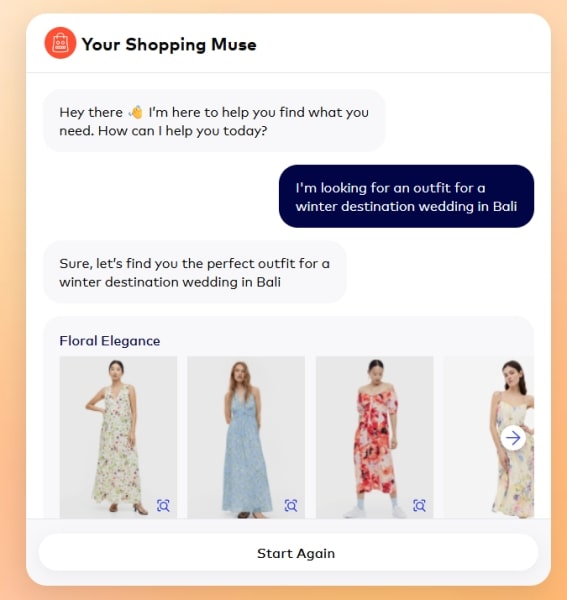
Most online shopping starts with a keyword. But Shopping Muse changes this. Customers type in full sentences like “I want something like what Beyoncé wore last week,” or “I need a warm outfit for a beach wedding.” The AI breaks that down using natural language processing, matches it with product data and past shopping behavior, and shows results that actually match the vibe. Instead of filtering by category, the user gets personalized suggestions right away—complete with product images, prices, and alternatives.
It doesn’t stop at text. A shopper can upload a photo of a look they love. Shopping Muse uses VisualML, its image recognition engine, to scan the image and find similar items—even if there’s no product tag. The AI looks at textures, colors, and shapes to offer something visually similar, acting more like a stylist than a search bar.
For customers who don’t have a profile or past order history, Shopping Muse doesn’t guess blindly. Mastercard’s broader data ecosystem kicks in, helping predict preferences based on regional trends, seasonality, and real-time affinity signals. This means even first-time users can see results that feel relevant.
AffinityML, Mastercard’s predictive model, helps map behavior patterns to product suggestions—without needing cookies or login data.
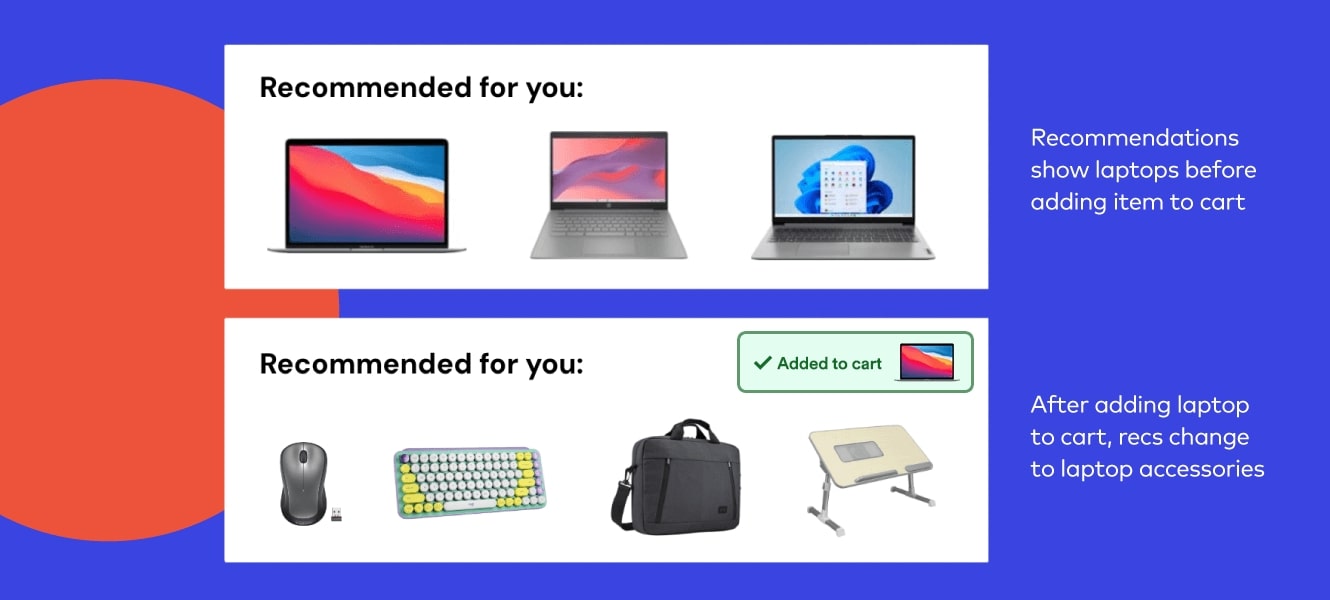
Shopping Muse is part of Dynamic Yield, Mastercard’s personalization platform that’s already used by hundreds of global retailers.
With years of development behind it and seven consecutive years as a Forrester Wave leader, Dynamic Yield helps businesses personalize everything from landing pages to checkout. Now, with Shopping Muse, they can also personalize how customers discover products from the first second they land on the site.
Retailers using Shopping Muse have seen faster product discovery and fewer drop-offs. Instead of scrolling through dozens of filters, shoppers are shown bundles, curated outfits, and accessories that actually go together. If a shopper likes a dress, they can ask for “something similar” and get a refreshed lineup in real time. If they want something more daring, they just say so—and the bot shifts tone accordingly.
Everything in Shopping Muse connects directly to a brand’s live product feed. That means results reflect inventory in real time—no dead links, no sold-out sizes. Brands can train the system to reflect their brand voice or prioritize sustainability, bestsellers, or margin-rich items. The tool also works across devices and integrates into existing ecommerce stacks, thanks to Dynamic Yield’s flexible architecture.
Shopping Muse isn’t trying to replace human help. But it’s making online shopping feel smarter, faster, and less work. Instead of clicking through endless categories, customers can just say what they want—and get results that actually make sense. That shift – from search to conversation – is what makes Shopping Muse a quiet but powerful change in ecommerce.
#Case 2 Shopify’s unified customer profiles in action
Shopify has found a clever method of bringing customer data to life with unified profiles that bridge online and in-store behavior in real time.
Take the sportswear retailer Mizzen+Main: when a shopper logs in, the system pulls together their order history, browsing patterns, and loyalty points – all visible to sales staff at the point-of-sale terminal.
As store manager Trey Pritchard said, “We open a customer’s profile and can see their full purchase history, which helps us make the right recommendations”.
This unified profile powers the automatic recommendation blocks you see beneath product pages. If a customer looks at a reusable water bottle multiple times, Shopify’s recommendation engine might display matching lunchboxes or bamboo travel cups.
The system pulls from multiple data sources – purchase history, product descriptions, browsing signals, and what other shoppers clicked – and updates in real time as stock levels change or new items arrive.
These features are built into Shopify’s Search & Discovery app.
Merchants can turn on “related” or “complementary” product sections with a few clicks, and Shopify does the rest—no coding or separate apps needed. It means stores can start serving smart suggestions in hours, not days.
The data engine also supports cart recovery and reminder tools. If a shopper abandons a cart with items still in stock, Shopify might display those exact products – or similar in-stock alternatives – when the customer returns. These gentle nudges help turn casual browsing into completed purchases.
This unified data model is powerful because it connects touchpoints across devices and channels. A customer may browse on mobile, leave items in a cart on desktop, then revisit in-store later. Shopify tracks it all and adapts each interaction in real time, giving customers a shopping experience that feels personal.
That kind of personalization, powered by data they already own, helps small and large brands close more sales without needing data science teams. In 2025, Shopify’s unified profiles make personalized product suggestions part of every store’s toolkit – and make shopping feel less robotic and more tailored to each person.
Dynamic pricing & payment personalization
Numbers that speak:
- Companies that use AI to inform their pricing strategies see a 2-5% increase in margins
- 87% of shoppers compare prices before buying.
Static prices are disappearing. Today’s stores are tuning prices live based on demand, inventory, or even how a visitor behaves on the page. Worldpay’s systems even choose the best payment route mid-transaction to lower fees without disrupting the experience. Smart pricing doesn’t only match competitors – it protects margins and keeps shoppers from bouncing.
#Case 3 Channable’s AI-powered repricing for marketplaces
Many sellers on Amazon and bol.com aren’t adjusting prices manually anymore. Instead, they rely on automated tools like Channable’s Repricer to keep up with fast-changing market conditions. Channable’s AI-powered repricing engine follows carefully set rules to protect margins and stay competitive. These rules depend on a mix of factors: competitor pricing, profit margins, customer scores, and delivery times.
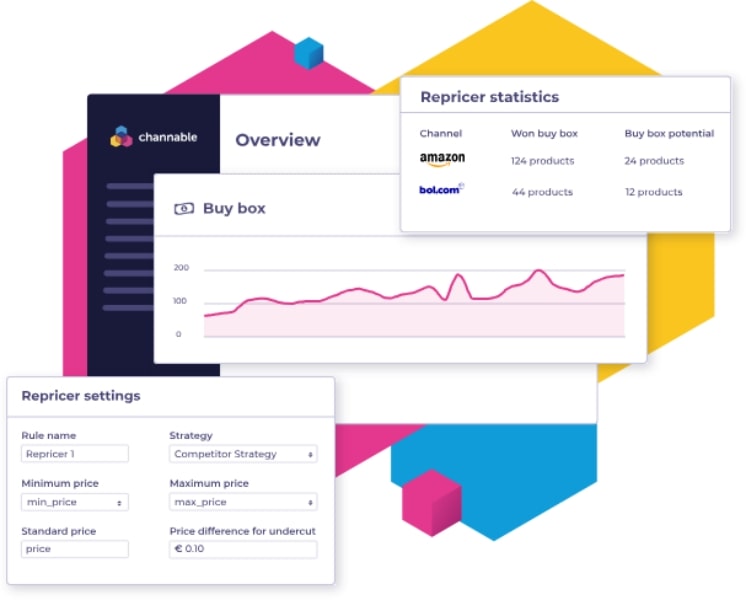
Tooltopper, a seller of over 20,000 DIY products, worked with agency 050media to test the tool on their marketplace listings. They found that 40% of their prices were misaligned with their marketplace goals. This meant missed chances at winning the Buy Box, which is the first spot buyers see when browsing products. By setting smart limits – minimum and maximum prices – they were able to react automatically to price changes by competitors, without losing profits.

For example, if a competitor listed the same drill set €2 cheaper, the Repricer could bring Tooltopper’s price down just enough to beat it—only if doing so wouldn’t cross the minimum profit line. If that competitor also had a slower shipping time or a lower customer rating, Tooltopper could keep the price higher, still win the Buy Box, and keep margins steady. Over time, this smart use of pricing rules led to a 5% increase in margin without any products dipping below the minimum set price.
Channable’s dashboard shows sellers which products are winning or losing the Buy Box and gives detailed performance reports. Sellers can also download CSV reports to track everything from pricing events to error logs. The tool supports more than 10 Amazon regions and includes a unique feature for bol.com sellers called “Price Stars,” where sellers can aim for certain pricing zones recognized by the platform as attractive to buyers.
All of this happens inside the Channable interface, so sellers don’t have to juggle multiple tools. The automation works in the background, constantly checking competitor prices and adjusting listings in real-time. As a result, sellers stay competitive, protect their margins, and grow sales—without spending hours a day watching the market.
#Case 4 How Worldpay powers profit optimization
Staying ahead in online retail means mastering two things: how you price and how you get paid. Worldpay has built tools to help merchants do both. It’s not only about accepting cards anymore but also finding the smartest path for each payment and shaping price tactics that respond to real-time conditions.
One of the standout features is Worldpay’s dynamic debit routing. Instead of sending every payment through the same route, this system uses AI to pick the cheapest and most successful option. According to Worldpay, companies using this setup in the U.S. have seen average savings of 28.2%. These are changes that affect every transaction and make a real dent in processing costs.
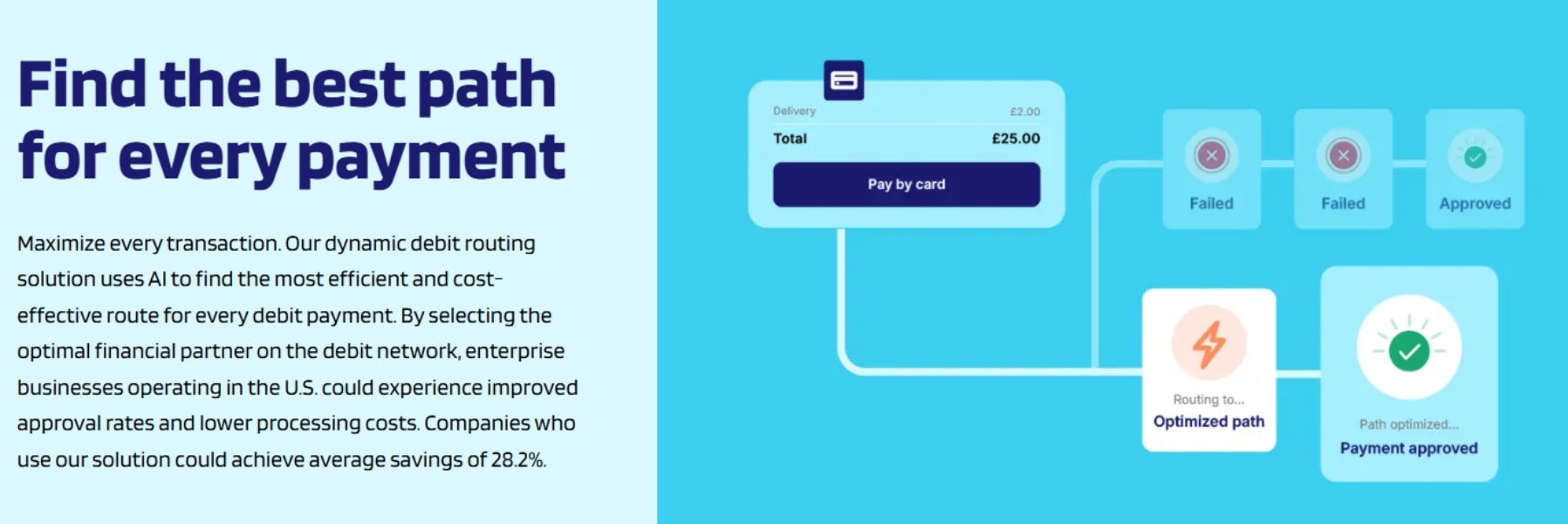
Then there’s Revenue Boost. When a card gets declined, most platforms stop there. But with this system, the payment is tried again – automatically, in the background – giving the transaction a second chance without bothering the shopper. For stores running big volume campaigns or targeting new markets, this means fewer dropped orders and more money in the till.
Another strong layer comes from Worldpay’s authentication tool, 3DS Flex. It’s built to make tough calls about when to ask for extra verification and when to skip it. The goal? Keep fraud low without losing good customers. It works behind the scenes, using data to guess which approach gives each transaction the best shot.
Worldpay doesn’t lock merchants into one acquirer either. Their agnostic token vault stores payment data securely, which gives businesses flexibility to switch providers or update systems without losing customer info. This setup is especially helpful for growing brands who want to stay agile.
Merchants using Worldpay can manage all of this inside one system – tracking errors, viewing success rates, and reacting to changes in buyer behavior. The approach is deeply technical but tuned for business outcomes. Worldpay’s work with retailers across industries – from fashion to finance – shows how data-led pricing and payments are shaping the future of ecommerce.
Custom customer journeys
Numbers that speak:
- Hyper-personalization is a top trend, with AI-driven journey mapping and real-time segmentation now standard for leading brands
- Retailers who invest in personalization see returns as high as 400%.
The old one-size-fits-all experience? Gone. Now, companies like Salesforce and Nosto use real-time segmentation to shift the store layout, recommendations, and content based on each visitor. A first-time browser sees something very different from a loyal buyer. Every part of the site responds to who’s using it – and how they’re behaving.
#Case 5 Stripe’s API-led customization
Imagine a shopper in Tokyo buying concert tickets on their phone. As they check out, Stripe instantly shows Apple Pay – everyone loves it in Japan for fast mobile payments. But a shopper in Paris sees Cartes Bancaires first, because that card is local to France. This is not random – it’s powered by Stripe’s smart systems learning which methods work best in each situation.
This clever system is driven by real-time signals on every session: country, device, purchase type, and past trends. When Stripe’s Optimized Checkout Suite picks a payment method that matches a customer, merchants typically see 12% more sales and a 7.4% rise in completed orders.
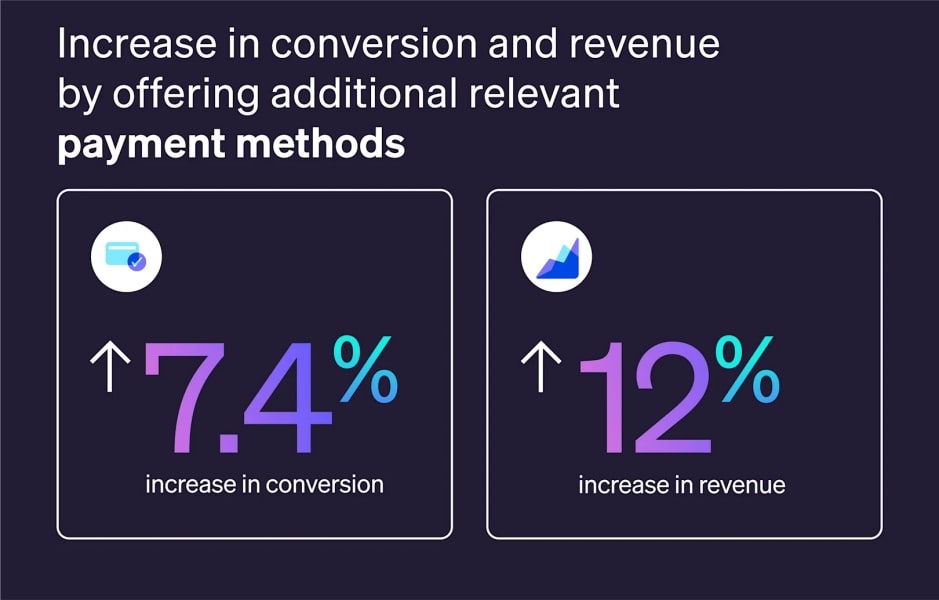
Even showing the right local method – like Alipay in China – can raise conversion by 91%. That kind of precision matters in 2025 ecommerce.
For example, a shop using Stripe’s suite saw a 3.5% jump in conversions after it began showing the best options by session, and 80% of Link users tapped it when available. This shows how the method adjusts to each customer’s needs.
All of this is possible because Stripe’s AI is trained on massive data – $1.4 trillion processed last year, 73% repeat buyers, and more than 100 payment methods supported. The AI checks hundreds of small signals in real time, choosing the payment that meets conversion and fraud rules best. The result? Fewer abandoned carts, fewer fraud issues, and more happy customers finishing their purchase.
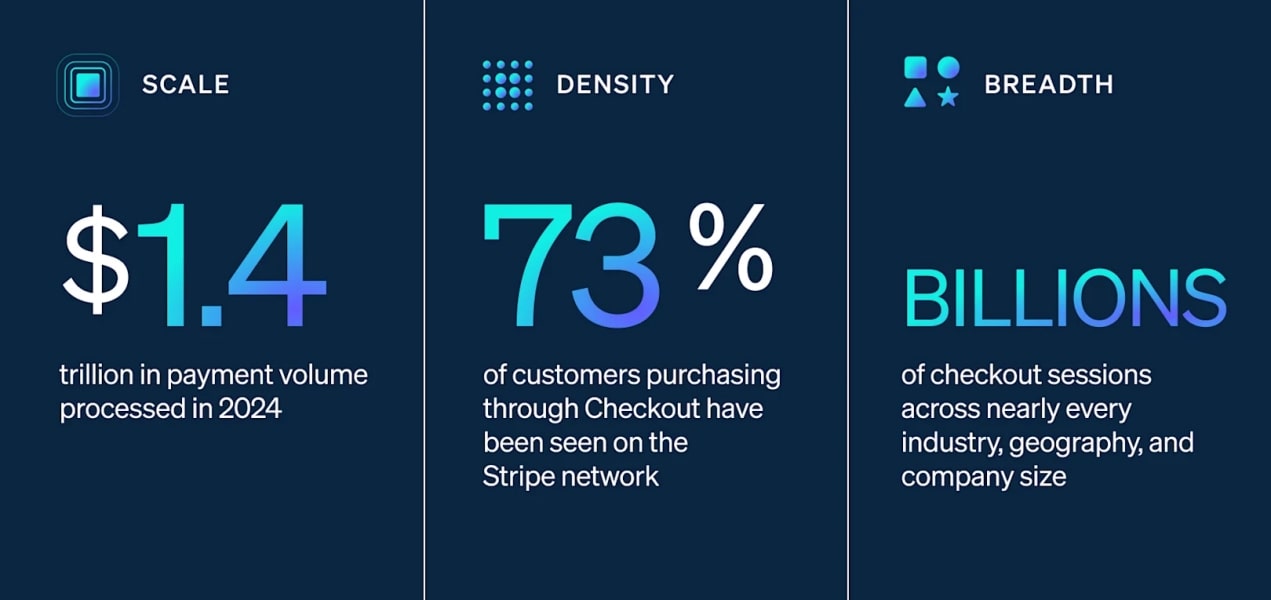
This intelligent checkout is a major change in ecommerce. No longer one-size-fits-all, it adapts to each shopper and each moment. It shows that sales and security can go hand‑in‑hand, all without merchants writing special code or maintaining rules. That is the power of Stripe’s flexible, API-built payment journey.
#Case 6 SalesForce’s Agentforce AI Orchestration Engine
In 2025, Salesforce introduced Agentforce’s AI Orchestration Engine to bring personalized shopping help across its platforms.
Picture a digital shopping assistant that knows each customer like a personal shopper at a store.
On a website, the agent can suggest outfits, upsell matching items, and help with returns—all by talking to the shopper in plain language.
Behind the scenes, Agentforce connects to data from Salesforce CRM, Commerce Cloud, and real-time stock levels, so every suggestion matches what the shopper actually needs.
Imagine your ecommerce store using Agentforce: a shopper uploads a photo, the system finds similar items, and then bundles accessories that match. It can also check delivery dates or order status right in the chat—no clicking through multiple pages needed. One retail brand reported that these AI agents handled stock recommendations, product descriptions, and guided shopping at scale across thousands of products.
What makes Agentforce stand out is its “Atlas Reasoning Engine” – a feature that breaks big tasks into small smart decisions, tests and learns quickly, and adapts to each shopper’s needs.
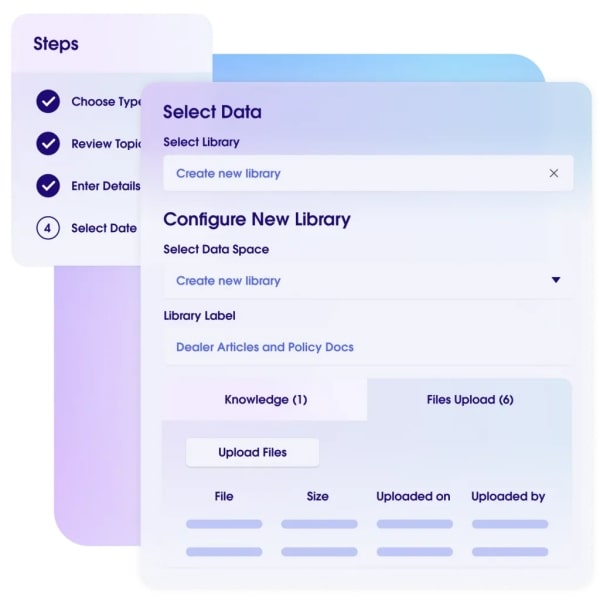
Agents follow strict rules so they don’t suggest items that are out of stock or break pricing limits. Retailers are already using these agents to increase sales and handle customer questions around the clock. In fact, prebuilt commerce agents now support merchandising teams by creating product bundles and updating descriptions in minutes – not days.
Salesforce even shared that in consumer goods, Agentforce is rising fast, with 43% of brands naming service bots as their top AI use case – and companies like SharkNinja using these agents across multiple product categories.
This innovation shifts ecommerce from static catalogs to a live chat experience that can respond just like an in-store assistant – no scripts, just smart shopping.
#Case 7 Nosto’s AI onsite behavior tracking
Imagine you’re chatting live with a store that truly adapts to your mood and interests – that’s Nosto’s AI onsite behavior tracking in 2025. At its heart is the Ecommerce Intelligence Engine, a system built by PhDs and data scientists over seven years. This engine watches every click, scroll, and view across thousands of stores and billions of shopping journeys.
Here’s where the story gets exciting: this AI reads dozens of real-time signals – product views, session paths, bounce rates—and instantly builds a customer profile. Instead of waiting for checkout data (which is just 1.6% of onsite information), Nosto responds to live behavior. If a shopper moves from browsing summer dresses to checking out rain jackets, the homepage content, navigation bar, pop‑ups and banners update right then and there.
This real-time AI journey mapping actually invents a unique funnel for each store. That means Nosto doesn’t assume static onboarding paths – its model trains on store-specific patterns and adapts per session. For example, a sports retailer might see a first-time visitor shown general gear, but a backpack page visitor instantly sees hydration packs or trekking boots next.
Data backs this up. Function18, a golf apparel brand, went live with Nosto’s real-time segments and onsite content personalization. They saw a 1.3× lift in conversion rate, shoppers spent twice as long onsite, and average order value jumped 18%.
The magic comes from segments that switch on the fly. Say someone clicks email subscribe and adds shoes to the cart – they move closer to buying, so Nosto might trigger a banner on free shipping. If someone lingers on technical specs, it might suggest video reviews or size charts. All of this updates mid-session, so customers see content that mirrors their mindset.
Nosto also surfaces deep insights. Merchants can see which categories convert best or which days drive revenue per visit. That helps them realign ads or focus content marketing where it matters most.
What sets this apart is its multi-channel reach. These real-time segments drive onsite personalization, but they can also power email campaigns, Google Ads, Facebook Ads, and custom mobile app experiences – all fed by the same behavioral tracker. And it plugs into Shopify, BigCommerce, and more, making it accessible even to mid-market teams.
This is innovation because it shifts personalization from pre-planned tactics to fully adaptive journeys. Instead of static rules or delayed triggers, every visitor sees a store that feels alive – responding to their browsing, shifting their experience, and making shopping flow naturally. In 2025, Nosto’s real-time journey mapping is a new brand of shopping intelligence.
Customer success & support personalization
Numbers that speak:
- Brands with personalized support see 44% more returning customers.
- By 2030, chatbots will handle 80% of all customer interactions.
AI is now at the front line of customer support. But instead of robotic replies, systems like Adyen’s and Algolia’s are built to respond in a human-like rhythm – fast, smart, and based on context. Whether it’s solving a payment hiccup or showing better search results, these tools step in early and guide shoppers smoothly. It’s support that understands before you ask.
#Case 8 Adyen’s platform
Adyen’s latest innovation, Adyen Uplift, brings AI into payments and support in a bold new way. This suite taps into over $1 trillion in transactions and data from more than 1 billion shoppers worldwide. That rich dataset gives Uplift a deep understanding of both shoppers and fraud patterns, letting it react in real time to each payment.
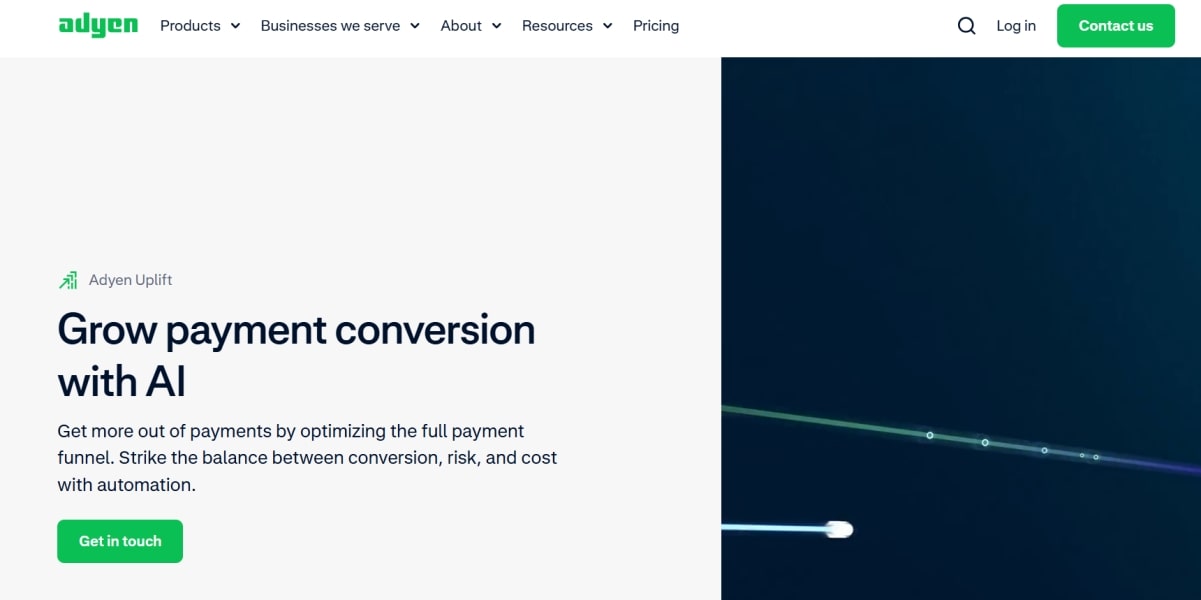
In pilot tests with 60 enterprise clients – including Patagonia, On Running, Indeed, NordSecurity, and Fubo – businesses saw payment conversion rise by up to 6% and processing costs drop by as much as 5%. Also, fraud teams cut manual rules by an average of 86%, with 35% of companies removing them entirely. That means the AI steps in to handle risk checks and route transactions without manual input.
One story comes from Nord Security, whose Head of Payments, Kes Saulis, said:
“We’ve increased our conversion rate on customer initiated transactions by 10% by leveraging Adyen’s AI technology, which optimizes the entire payment funnel while maintaining control over fraud and costs.”
And On Running’s digital team shared that Uplift drove a 2% increase in success rates – making a real impact on both performance and cost.
Behind the scenes, Uplift uses risk-based intelligence and automated conversion tactics. It automates fraud control with no rule-writing, recovers failed payments, selects the most cost-efficient route for debit transactions, and updates authentication dynamically. This suite adapts checkout flows, chooses the best paths, and balances customer experience with risk and cost. For example, it uses token vaults for repeat buyers, picks authentication routes smartly, and runs auto-retry on failed payments.
This is innovation in e‑commerce because it treats every payment like a mini strategy session. Instead of manual trade-offs between approving payments and catching fraud, the AI handles multiple goals at once. Shoppers who’ve proven trustworthy can check out faster, while questionable transactions face tighter checks – all without slowing business down.
In short, Adyen Uplift transforms payments and support from a cost to a competitive edge. Ecommerce businesses no longer must pick between conversion, fraud control, or cost – they can have all three, managed by real‑time AI.
“AI is no longer viewed as a future bet—it’s a current imperative for retailers and consumers alike,” commented Holly Worst, VP of Retail at Adyen. “Earlier this year we launched Adyen Uplift, our AI-powered payment optimization suite that helps businesses increase payment conversion, simplify fraud management, and reduce the cost of payments. By embracing AI in this way, we can help retailers offer an unparalleled customer experience as ‘good’ shoppers are able to speed through checkout whilst we can intercept fraudulent transactions. It is clear to see why AI has taken the top spot as the most-cited growth enabler for 2025.”
#Case 9 Algolia’s advanced personalization
Algolia takes customer success to a new level by making each shopper feel heard and supported throughout their journey. Their Advanced Personalization engine creates a unique profile for every user, based on real actions like browsing categories, clicking on items, or purchasing. This builds a picture of what each person likes and tailors the experience to them.
This engine scores each customer across over 100 traits—brand interest, price range preferences, favorite categories – and those scores guide what they see when they search or browse. Because this happens in real time, the experience can change within a single visit: a shopper who begins casually looking can suddenly see deeper offers once they start showing buying behavior, all without manual rules. That split-second response makes users feel understood and stops them from drifting away.
From a business angle, Algolia’s platform carries real weight. A Forrester Total Economic Impact study found that implementing their Search & Discovery solution yields a 382 % return on investment over three years. Companies saw search relevance improve by 40–50 % and conversions rise by about 10 % after applying dynamic re-ranking.
Real stories underline this impact. A fitness clothing retailer reported earning around $8.5 million extra each year simply by switching to Algolia – not from a fancy redesign, but from better product suggestions. Another client, PCComponentes, grew their search clicks by 81 % and achieved four times more conversions after adopting Algolia’s recommendations engine.
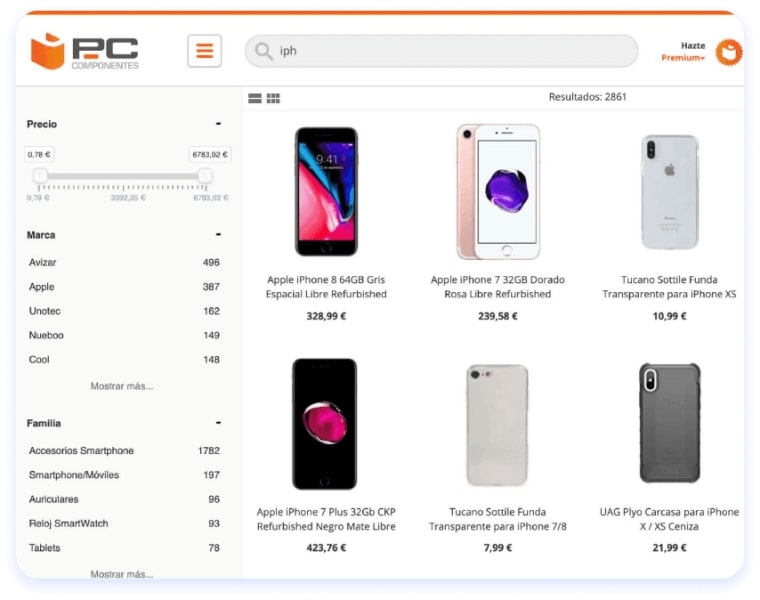
All of this makes Algolia’s tech more than a search box – it acts like a personal assistant. Developers can implement personalization with just a few API calls, while merchandisers use a dashboard to tweak settings or simulate results without needing engineers. Business teams can add extra data, like Shopify or BigQuery stats, into customer profiles to sharpen personalization even more.
This is what makes Algolia stand out in 2025. Rather than blunt, generic experiences, stores powered by Algolia are reacting to each shopper’s signals and helping them find what they want faster. By combining rich real-time data with scalable search tools, Algolia transforms generic browsing into individual journeys – this is customer success built into the tech.
Over to you
The companies leading the charge are, without a doubt, trendsetters.
With every personalized search or AI-driven chat, they’re reshaping what online shopping feels like.
Next time you shop, know this: what seems easy on the surface is powered by deep tech underneath run by people and platforms who know what matters.
Feel free to come back to these examples when you want to personalize the shopping experiences of your customers and need inspiration.
***


